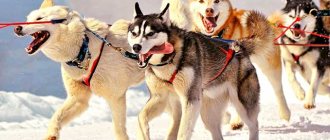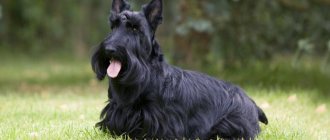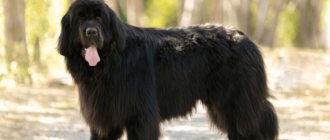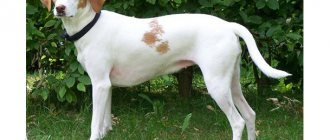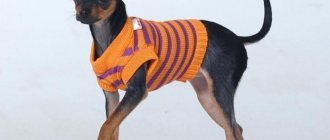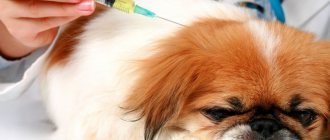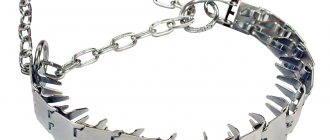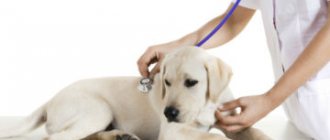What is agility
What epithets come to mind when we think about dogs - agile, fast, jumping. Agility is a sport in which all these qualities of a dog are revealed more than anywhere else. The word “agility” is translated from English - speed, dexterity.
Agility competitions involve the participation of not only the dog itself, but also the owner or his representative. The person performing with the dog is called the handler. He guides the animal on the obstacle course, helps with commands, and corrects behavior.
The competition itself takes place in the form of an obstacle course. This is another plus for the popularity of agility, because such competitions are quite easy to organize. Typically obstacle courses should be 200 meters long. Obstacles are located on them every 10 meters.
The strip may not be straight, but in any form that the organizers come up with. This loading of obstacles allows not only the handler and his ward, but also the spectators, of whom there are many, to enjoy the process.
Agility rules
In agility, the rules boil down to the following:
- one attempt to complete the route;
- provision by the organizers of a map of the area with obstacles before the start of the competition (except for the additional zone);
- provision by the organizers of one “trial run” before the start of the competition (except for the additional zone;
- a person moves along an obstacle course next to his animal, directing the dog with his voice and gestures - contact, whistle, feeding or toys on the field are unacceptable; if there is a treat in the owner’s pocket, the team is disqualified;
- judges take into account the speed and cleanliness of the passage if the animal passed the strip very accurately, but too slowly it is just as bad as a very fast but “dirty” passage.
These are general rules, more detailed rules depend on the agility class in which the competition is held.
Types of obstacles in agility
There are the following classes of this sport:
- standard – at least 15 obstacles with color markings;
- jumping – numbered obstacles with a predominance of “jumps”;
- jackpot is a whole game, with an introduction, the main part and a conclusion, during which the dog scores points, the most interesting agility class;
- snooker - built completely similar to the rules of the billiards game of the same name;
- relay race – teams of 2 or more “master-dog” pairs run a standard course, the overall result is taken into account.
Each society of agility lovers sets detailed and detailed rules independently, prescribing the class of sport in which they plan to engage. Of course, “local detailing” should not contradict the basic general rules of competitions and agility classes .
History of appearance
Since its inception, agility has been simply entertainment for spectators. At one of the dog shows in Great Britain, one of the organizers, John Varley, made an attempt to entertain the spectators. He wanted to show something that no one had offered before that moment. He was assisted by his friend Peter Meanwell.
Since both were fond of equestrian sports, it occurred to them to take the obstacle course as a basis from there. Some elements and obstacles were copied. Something was invented additionally, specifically for the dog.
In 1978, at an exhibition, friends first presented such entertainment to the attention of viewers. Everyone was delighted. Such competitions were repeated the next year, at another exhibition.
After a short amount of time, agility was officially recognized as one of the sports.
In Russia, the first agility championship was held in 1994. The number of participants for our huge country was very small - only 12 couples. The following year, the Russian Cup was held, the importance of the competition was emphasized by the fact that Jean Paul Petididier, the chairman of agility in the FCI sports committee, acted as the chief judge. Since 1996, Russian teams have been regular participants in the World Agility Championships.
Which dogs are suitable for agility?
Any dog can participate in this sport, regardless of size (although in competitions dogs are divided into size classes - small, medium, large) and breed, as long as they have a passion for an active lifestyle, have endurance, agility, mobility and are capable of obedience.
However, heavy animals are not entirely suitable for agility, since it is difficult for them to overcome barriers and some other obstacles, they are less maneuverable, and they require more time to turn. And excessive physical activity has a negative impact on joint health.
Therefore, if you intend to practice agility with your dog, you should choose your dog carefully. A puppy is chosen for a sports career at an older age, starting from 8 months, although obedience training should be carried out as early as 4 months. Admission to competitions is only from 15 months. It is easiest to work with a young dog, which can be trained more quickly and easily adapts to new conditions.
It is important to take into account the main characteristics, which include mental state, physical capabilities, and physique. The dog must have a balanced psyche, a stable nervous system, because in the process of training and competition the animal will be affected by various stimuli, in particular noise, the presence of other dogs, crowds of people and the animal must be able to adapt to changing environmental conditions. Of course, it is difficult to evaluate a puppy according to this criterion, but you need to pay attention to his parents, observe how he interacts with littermates and people.
Basically, the puppy is assessed on physical parameters, in particular on activity, mobility, and desire to play. To assess physical capabilities, tests are performed on speed, endurance, and jumping ability.
The success of a sports career largely depends on body structure. It is important that the dog has developed muscles and the structure of the musculoskeletal system is ideal. Otherwise, the risk of injury during the course increases, especially when jumping. The advantage is a strong, flexible and straight back, a long and wide croup at an angle of 30 degrees to the horizon. If we talk about the correct structure of the limbs, then ideally:
- the shoulder blade is long and located at an angle of 45 degrees to the horizontal;
- the shoulder is long and connects to the shoulder blade at an angle of 90-100 degrees;
- the elbow is set straight back;
- the forearm is vertical;
- the wrist is strong and the metacarpus is sloping or vertical;
- the fingers are pressed tightly against each other, causing the paw to become rounded (“in a lump”);
- the femur is long and connected to the pelvis at an angle of 90 degrees;
- the knee joint has an articulation angle of 125-135 degrees;
- the lower leg is long, but the same length as the forearm of the forelimbs (with a short lower leg, jumping is difficult);
- the hock joint has an angle of 135-150 degrees;
- The position of the limbs is parallel.
In general, the structure of the body should be proportional and movements should be free. The exercises are easiest for dogs whose height at the withers is 30-39, 45-55 cm. The length of the coat also matters. With short hair it is easier to overcome obstacles, because the hair does not get in the way or catch, although there are many long-haired dogs in agility.
What matters is the health of the animal, which should not have any chronic diseases. The animal must have developed hearing, vision, and a sense of balance. Although there are cases of successful participation of deaf dogs in competitions. In such cases, the main thing is that physical activity does not contribute to the deterioration of the animal’s condition, and that the pet itself enjoys the process.
The largest number of athletes are representatives of the breed: Border Collie, German Shepherd, Australian Shepherd, Malinois, Poodle, Sheltie, Fox Terrier, Jack Russell Terrier, Miniature Schnauzer, Spaniel, as well as outbred miniature dogs.
Dogs participants
Another advantage of agility is its complete openness to dogs of all breeds. It would be more accurate to say that outbred dogs can also take part. There are no admissions in the form of pedigree or other evidence of the breed.
But restrictions still exist, although they are advisory in nature:
- age. In agility competitions, it is better to enter an animal over a year old. The skeleton of such animals and their psyche have been formed. This will help protect you from injury on the obstacle course. It is better not to bring your puppy to competitions;
- pregnancy. Pregnant bitches are not allowed to participate;
- training. Dogs must be able to comply with the handler's demands, know basic commands and be able to overcome obstacles.
Although the breed does not matter, it has been observed from experience that agility is best suited for herding breed dogs.
For convenience and for equality of tailed participants, they are divided into categories:
- “S” - small - less than 35 cm at the withers;
- “M” - medium - 35-43 cm at the withers;
- “L” – large – from 43 cm at the withers.
The competition begins with participants from the S category, then the other two in succession. This happens because some equipment on the obstacle course are adjusted specifically to the height of the participant. For example, the height of the barrier.
Based on the experience of holding competitions, certain dog breeds have already emerged that most often become winners in their categories. In the “small” category, the most successful dogs are the Spitz breed, in the “medium” Sheltie, and in the “large” category – the Border Collie. Border collies are very fast dogs. Many breeders use a trick and breed a Border Collie dog with a height that allows it to compete in overcoming obstacles in the smallest category, where it is among the leaders.
Dog agility training
As in any sport, in agility training it is important to do everything correctly and as successfully as possible without harming your health. Here are some general guidelines for training your dog on your own.
- You can start training from 4 months of age, but to start agility training, the dog must know basic commands and clearly follow them;
- From the very beginning of training, you need to organize everything so that the dog perceives it as entertainment, then the effectiveness of the training will be higher;
- It is better to train in a dog training school, where the obstacles are properly made, which eliminates the possibility of injury to animals, and where the dog will get used to working in conditions where there is noise and a lot of strangers around;
- At the initial stages of training, you should not give the dog a heavy load, use high obstacles, etc., and you should also protect your pet on the apparatus from accidentally falling;
- There is no need to try to teach your dog all existing equipment at once - do it gradually so that the dog does not get confused and does not experience unnecessary stress;
- Classes are usually held several times a week for several hours, so you will need to be prepared for physical activity;
- If you cannot cope with such loads or want your dog to achieve results in the shortest possible time, you can use the services of professional handlers who specialize in training dogs in agility and accompanying them in competitions.
Agility should be a game for a dog, a pleasant pastime. Photo: SheltieBoy
Agility equipment. Initially, for training, you will definitely need a treat, for the sake of which your pet will be most willing to perform various tasks. You may also need a collar and leash, but try to stop using them as soon as possible, because nothing like that is allowed at competitions (neither a collar, nor treats, nor even the presence of a leash on the handler).
And, of course, to practice passing the agility course you will need special equipment. Dog training schools usually have them, but if you want to train your dog at home, you will need to make them yourself. In this case, it is imperative to take into account the size of the dog and its capabilities, and, most importantly, the safety of the projectile for it.
What shells are used
The International Canine Association has established the types of equipment that are used in agility. The main requirement is safety for the pet. The organizers themselves can mix them on the obstacle course in any order. It is allowed to install obstacles in any way.
All projectiles are divided into two groups:
- Assume contact with the participant;
- Does not involve contact.
Contact
- "Slide". Two planes connected in the form of an inverted “V”, the highest point is at a height of 1.5-2 meters from the ground. Wooden strips parallel to each other are attached to them, providing an anti-slip effect. The handler gives the command: “Home”, “Slide”.
- "Swing". Similar to a children's swing, on which two people ride, located at different ends. At the moment when the pet begins to move along the projectile, one of the sides moves down and the handler gives the command to move: “Swing”;
- "Boom". Unusual slide. The difference is that the shields are not connected at an angle. And between them there is a wide board along which the pet must run. In some ways the apparatus resembles a gymnastic beam. They give the command: “Boom”;
- "Tunnel". The obstacle looks like a wide pipe. The tunnel can be soft or hard. Positioned differently on the obstacle course. They give the command: “Tun” or “Bottom.”
Contactless
- "Barrier". The projectile is designed according to the principle used by track and field athletes. Two supports with a transverse bar, which is knocked down if necessary, so as not to injure the animal in the process of overcoming obstacles. The dog must pass the barrier without knocking down the bars. Command: “Jump”, “Up”, “Hop”;
- "Ring". The point of overcoming the projectile is for the dog to jump through a ring fixed to the posts. Team: “Circle”, “Tire”, “Bar”.
- "Bounce". Jumps must be performed by the dog on command, over several obstacles at once. Command: “Hop”, “Jump”, “Up”;
- "Slalom". The animal must run around twelve obstacles in the form of racks located strictly along the line. The passage is a snake. Command: "Trrr";
- "Podium-square". A square-shaped area located at a height specified for different categories, from 2 to 75 cm. The dog must jump onto this square and fixate there for a certain time: “Hop”.
Competition rules
The rules of agility are democratic. Usually the organizers do not require any documents and do not set requirements regarding the breed of dogs - you can even come with a mongrel, the main thing is to show class.
The exception is certified competitions, where agility is preceded by a mandatory examination of the animal. But even during such checks, the judges’ attention is focused not on the dog’s appearance, but on how quickly and clearly it is able to carry out commands. They also look closely at the handler himself: how correctly and correctly he gives these commands.
The owner goes the entire distance with his pet, helping him with voice commands, gestures and poses
Important! You cannot deliberately touch the animal and motivate it with treats and toys.
The obstacles on the course are formed in such a way that the dog will not be able to pass it alone - an assistant is needed. The judges conduct a preliminary assessment of the composition of the participants, all equipment is marked. Each team has only one attempt to complete the distance. At the end, the results are assessed, which can be adjusted with reference to the physiological characteristics of the animal. The assessment is given in points.
Teamwork
The owner of the dog has the right to inspect the track after walking along it once. This helps him develop a strategy and think through the sequence of commands. Any physical punishment of an animal immediately leads to disqualification. In general, at different competitions the rules can differ significantly - much depends on the level, complexity of the route and the amount of the prize.
Agility is a team sport
How are agility competitions held?
There is no training allowed on the track, so the dog must already be familiar with all the equipment and obstacles used in competitions. Shortly before the start of the competition, the judge gathers all participants and informs them about the details and features of the event, norms and time limits. Also, the judges once again spell out the rules and explain by what criteria the marks will be given.
Video - Russian Agility Championship 2021
Then both athletes - man and dog - take their place at the start at the signal from the judges. All collars, including flea collars, are removable. The dog takes the initial position, it depends on the requirements of the particular competition. The judge gives the command to start, the handler gives it to the dog. Time begins from the moment the animal crosses the starting line.
While jogging it is not allowed:
- touch an animal;
- touch the shells;
- hands must be free, it is forbidden to hold any objects in them;
- pass or jump over obstacles yourself;
- motivate your dog with treats.
Allowed:
- giving commands by voice and any gestures;
- the handler's presence at the distance for an unlimited time (but within the limits established by the judges).
Shortly before the start of the competition, the judge gathers all participants and informs them about the details and features of the event
The time is recorded at the moment the animal crosses the finish line. The judge's decision cannot be changed or appealed; another attempt is also not provided. Repeated passage of the course is possible only if two dogs received an equal number of points and the winner must be determined.
Remember that agility is not only about running at speed with obstacles, it also evaluates skill.
Types of obstacles
Every agility event has the usual set of obstacles. Only the height, size, and distances between the projectiles can differ. They are selected not only based on the dogs’ physical characteristics, but also taking into account animal psychological characteristics - the dog must show not only energy, but also endurance and the ability to follow commands.
The set of obstacles includes:
Standard:
- Slalom. It consists of 12 vertical flexible poles dug into the ground or fixed on small platforms. The dog must go through this obstacle in a zigzag, like a snake.
- Platform. This obstacle is a kind of podium with inclined bars along which the dog climbs onto the platform and descends from it. On the horizontal part, the animal must remain in a pre-agreed position for as long as the judges set before the competition.
- Zone (square). A small space is allocated on the route, which is limited by a tape that defines the perimeter of the zone. When the dog gets to this part of the test, he takes the desired position and remains in this state for some time.
Slalom
The following contact and non-contact barriers are added to the judges' choice.
Contact:
- boom. These are three boards 20-30 centimeters wide, the structure of which resembles a bridge. The boards themselves are located at a height of a meter from the ground, and inclined beams lead to them. The dog must climb onto the bridge with its paws. If she just jumps, the judges will count penalty points for it. A person is allowed to walk next to an animal to insure it;
- slide. These are two boards connected to each other, the width of which can reach one meter. Fastened at the ends, they form a triangle 2-3 meters high. The dog must climb up and down these boards, using his paws all the way;
Slide
- swing. It looks like a children's swing, consisting of one board fixed above the ground in the middle. In the case of dog competitions, the swing is a bar up to 40 centimeters wide and 2-3 meters long. A load is attached to the entrance side. The four-legged athlete’s task is to run a little further than the middle of the bar, wait until the swing is completely lowered down from the exit side and run away from the obstacle;
- pipe. A hollow structure, in simple words, is a large-diameter plastic pipe. It can be located directly on the ground or suspended at some distance from it. It depends on the purpose, whether the dog should run or crawl in it, as well as on the characteristics of the participants themselves. The dimensions and capabilities of the animal also determine the length of the pipe;
- tunnel. Usually this is a corridor whose looms are fabric. This material is used for sound permeability so that the handler can give commands with his voice, telling the animal the direction of movement. The judges recognize this obstacle as successfully passed if the dog manages to pass it without stopping even once;
- transition. This is a platform with a number of descents. Two of them have contact zones marked. The dog must pass the test, relying on the voice of the owner.
Video - World Championship 2021
Contactless
- jumping. The idea of these obstacles was completely borrowed from horse show jumping. This is a pole mounted vertically on two slats. The dog must jump over it without touching it. There are single, double and triple. In the last two cases, obstacles are installed at a small distance from each other;
- fence. The animal must also jump over this projectile. The difference with “jumping” is that the fence has the appearance of a solid shield or hedge;
- tire. A round barrier is attached to a square frame. Usually a simple car tire wrapped in plastic is used. The dog jumps over this tire.
Tire
When agility is conducted specifically for small breed dogs, contact obstacles are usually chosen. For medium-sized animals, the course is made up of mixed obstacles. For large dogs, obstacles are selected according to their size - it is important that the animal does not get stuck in the apparatus and is able to climb it safely.
Video – Agility training
Regulations
There are no clear and strict rules for agility. The evaluation criteria are also not clearly defined.
There are a number of restrictions:
- The dog should not be wearing a leash or collar while overcoming obstacles;
- the handler cannot use any means of encouragement;
- Contact between the handler and the dog on the strip must be excluded.
You cannot help your pet overcome an obstacle. Before the competition, the handler can inspect the stripes, understand where and how the obstacles are located, think through the passage, and calculate the strength of the pet.
There are two criteria for assessing exercise performance:
- cleanliness of obstacle passage;
- time.
It cannot be said that any of them is decisive. However, the cleanliness of performing exercises on the band is still more important than time.
Penalty points are awarded if:
- the dog did not meet the allotted time;
- the pet went through the wrong gate;
- contact between the handler and the dog or obstacle;
- the pet refused to work.
Fines are also imposed on the handler for negative behavior: cruelty to the pet, rudeness towards the judge.
Ultimately, the winner will be the dog that runs the entire course with the optimal cleanliness-time ratio.
Agility classes
Today, FCI rules establish two official classes of agility competitions.
- Standard. This class is a classic agility sport that includes all three types of obstacles. For beginner athletes, a platform with 15 apparatuses is used, while for experienced participants their number can reach 22.
- Jumping. A special feature of this class of competitions is the presence of only jumping obstacles and a starting platform. Depending on the specific competition, the agility course may also be supplemented with tunnels and slalom. Due to the absence of contact projectiles that slow down movement, jumping dogs develop the highest speed.
Competitions may also include the following types of agility that are not approved by the International Canine Association.
Joker or jackpot. This competition is divided into two periods:
- during the introduction, the dog overcomes obstacles at the handler’s discretion, earning points;
- Finally, the animal must overcome a series of obstacles selected by the judge in a short time.
The difficulty is that in the second period the handler must not cross the line, which is drawn at a distance of 3-6 m parallel to the obstacle course, thereby he has to control the dog from a distance.
Snooker. Designed after the game of billiards, this variation of agility involves jumping over numbered obstacles - three red ones for jumping with the number 1, and six other types, numbered from 2 to 7.
The competition is divided into 2 stages:
- at the introductory stage, the dog passes the first one of the red obstacles with number 1 and one of the additional ones with numbers 6-7, then this is repeated with the remaining two main equipment;
- at the final stage, the dog must pass consecutive obstacles numbered 2 to 7 to gain additional points.
Relay race. At this competition, 2-3 teams of handlers with dogs sequentially pass an obstacle course located on the agility site (each with its own section), passing batons to each other.
Competition levels
During the obstacle course competition, the dog must receive an “Agility Certificate.” It is issued if there are three “Excellent” ratings at the first stage.
Further, the dog’s level of participation depends on previous achievements:
- Agility 1 and Jumping 1. Participants: those who are new and those who have not yet received a Certificate;
- Agility 2 and Jumping 2 Participants: those who already have a Certificate;
- Agility 3 and Jumping 3. Participants: those who have prizes for victories at previous levels and in Jumping 2, at least three.
Where can you learn agility in Russia
| City | School name | Contacts |
| Moscow | Canine | +79161564436 |
| Moscow | Canine | +79261766641 |
| Moscow | Kennel club "Rublyovka" | +79152000705 |
| Moscow region | Canine training | +79165216556 |
| Saint Petersburg | Association for the Development of Cynological Sports (ARKS) | |
| Permian | Rudashevsky School of Agility | +79226406235 |
| Tver | TRFKS | +79108365246 |
| Samara | SOOO TsLS Image Dog | — |
| Kazan | Federation of Sports and Applied Dog Breeding of the Republic of Tatarstan FSS RT | +79053100383 |
| Rostov-on-Don | RROO FKS | +79281459527 |
How to train
An indispensable condition for a successful performance is the dog’s ability to follow commands and overcome obstacles, close contact and mutual understanding with the handler.
Classes to prepare for competitions can be conducted at home, on sites near the house, or in nature. You can make simulators so that your pet has an idea of the obstacle course that will have to be overcome.
But, of course, the best option would be training on the basis of a kennel club. There the conditions are as close as possible to competitive ones. The obstacle course in such schools and clubs completely replicates the professional ones. The pet will get used to following commands surrounded by other animals and going through trails. That is, he will gain some competitive experience. And the handler himself will gain experience of participation and understand how to correctly overcome obstacles.
The only disadvantage of classes at the club is the cost. Training lasts on average 3 hours, 1-2 times a week. The cost is usually no more than 500 rubles per lesson.
Preparation tips:
- interest your pet, training should take place in the form of a game, but with unobtrusive control;
- Offer your pet a variety of exercises to overcome obstacles. Don’t turn exercise into a routine; even the most persistent lover of running will soon get tired of the monotony;
- Never show annoyance or punish your pet for incorrectly following commands.
How to start agility training
Before teaching a dog agility, it is necessary to instill in it the basics of obedience, that is, the skills to perform basic commands - “Sit!” , "Lie!" , "Stand!" etc. This way you will establish closer contact with your pet, teach him to understand voice commands and gestures. After this, you can conduct agility training yourself.
Classes can take place both at home using purchased or homemade equipment, and in cynological schools. The second option is preferable, since your dog gets used to following commands not only in a calm environment, but also in the presence of extraneous stimuli in the form of other dogs and people. And at the same time, you have a unique opportunity to communicate with like-minded people and learn from their experience. As a rule, amateur classes take place 1-2 times a week and last 3 or more hours. The price for agility in Moscow in most cases does not exceed 500 rubles per lesson.
Classes must be structured so that the pet finds it interesting. Remember that for a dog, agility training is not a duty, but entertainment, a way to release its overwhelming energy. Vary the tasks and make changes - this will help prevent your pet from becoming bored with the exercises and prevent their rejection. In addition, at first, try not to show the animal your annoyance and under no circumstances hit him for passing the projectile incorrectly . On the contrary, actively praise and encourage correct behavior and simply ignore incorrect behavior. This will help your dog develop a positive attitude towards training and look forward to it.
If you want to get acquainted with the detailed rules of the competition, requirements for animals and their owners, want to clarify at what age a dog can train in agility, etc., use the information from the official website dedicated to this sport in Russia, or contact to your nearest dog training center. Remember that the most important thing is not achieving victories, but the feeling of complete unity with your four-legged friend.
Briefly about the main thing
- Agility is a sport for the dog and the owner;
- The sport originated in England in 1978, Russia has been a participant in international competitions since 1996;
- A pet of any breed or a completely mongrel can become a participant;
- There are dog breeds that are more successful in this sport;
- Agility has three levels of difficulty, depending on whether the dog has a Certificate;
- You need to prepare your puppy gradually and better in a kennel club;
- There are three difficulty levels in the competition;
Competition rules
Agility has become so widespread that in 2012 the Fédération Cynologique Internationale created rules. This paper includes the main provisions, categories of participants, rules for judges, strictly defined requirements for equipment and making a decision.
The goal of the dog and the owner is to overcome the strip quickly and accurately. The pet needs to go through the tests on its own, but under the control of the owner. He can only help with gestures or voice commands. Typically there are from 16 to 26 obstacles on the course. It is important that the dog goes through the course for the first time, that is, he was not familiar with it before the start of the competition. Only previously acquired skills are used in the process. The owner quickly studies the route shortly before the start.
The dog gets a high result not only for speed, but also for caution. If she knocks down the bars and hits obstacles, points will definitely be deducted.
There are also a number of rules in competitions, for disregard of which participants may be disqualified. This is mistreatment of the pet, disrespect for the judge, the dog’s refusal to carry out a command (three times), the animal’s disobedience, its aggression, the end of the set time.
Video: Agility for dogs: what is it and how to teach a dog?
